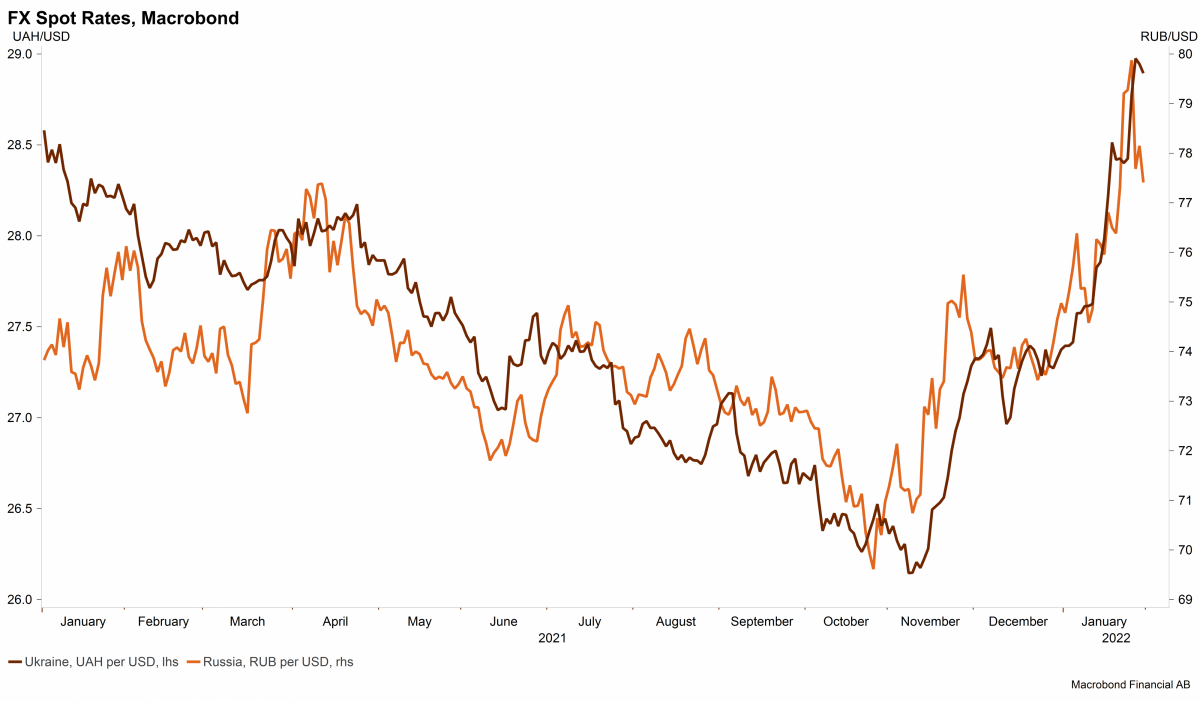Russia and Ukraine: Heightened tensions at the border increase uncertainty and weigh on business environment risk
Event
Russia has amassed troops close to the Ukrainian borders since November 2021, and diplomatic negotiations have not diffused the high tensions so far. The West continues to be committed to keeping NATO open to new members, rebuffing a central security demand for Russia. While diplomatic negotiations continue, Russia received implicit support of China last week. The context is highly uncertain, but the tensions between Ukraine and Russia have never been higher since 2014, which was marked by the annexation of the Crimea and the war on the Donbass.
Impact
In this uncertain context, the risk of escalation is high. The US and the EU are likely to respond to an escalation by imposing new sanctions on Russia. The US is reportedly finalising sanctions that might target the financial institutions and/or impose export controls that would limit its access to western technology and/or cut off the country from the SWIFT international payment system – which is deemed an unlikely scenario. Russia is likely to respond to the imposition of sanctions by imposing countermeasures that would affect the EU economy, which is already affected by high energy prices.

On the economic front, the high uncertainty is weighing on the risk of debtor default through the deterioration of the business environment risk, driven by the depreciation of the Ukrainian hryvnia and the Russian rouble (cf. graph) . The other indicators have remained largely unaffected so far, even if the prolonged uncertainty is likely to weigh on economic activity. Nevertheless, according to recent projections (based on assumptions of an absence of an expanded conflict), real GDP growth is expected to decelerate only slightly: the real GDP of Russia and Ukraine is projected to increase in 2022, respectively by 2.4% (from 4.5% in 2021) and by 3.2% (from 3.4% in 2021) according to the World Bank (January 2022). In both countries, the inflation rate has been on the rise (rising to 8.4% in Russia and to 10% in Ukraine in December 2021). Yet, this rise had already started before the tensions began to increase. As a result, both central banks increased their policy rate in 2021. All in all, in both countries, even though uncertainties have increased, mainly the exchange rate has been hit so far. The evolution of the other indicators is largely driven by other prevailing factors (e.g. global inflation pressure amid high commodity prices and supply chain bottlenecks, fallout from Covid-19).
Last but not least, it should be noted that Russia’s macroeconomic fundamentals are very strong. First of all, the country’s liquidity is excellent, with low short-term external debt and a high level of foreign exchange reserves. Secondly, public finances are very solid; public debt was below 20% of GDP in 2021. Thirdly, the current account is in surplus, and finally, the banking sector is not reliant on external funding. Ukraine’s economic fundamentals are weaker than Russia’s indicators, but much better than in 2014. Indeed, the exchange rate is now flexible, which means that foreign exchange reserves are no longer under severe pressure in case of an external shock. The central bank is more independent as well. Thanks to the approval of the (much-delayed) first tranche of the IMF Stand-By arrangement in November 2021 and the SDR allocation in August 2021, gross foreign exchange reserves have increased to USD 29.4 billion in December 2021. Even so, the current account deficit is expected to widen to 2.7% of GDP this year (from 0.1% in 2021). Public finances are also in better shape than in 2014, as public debt reached about 50% of GDP in 2021. The same goes for the banking sector, which now has a positive foreign asset position.
In this context, while there is no immediate change in country risk classification, the outlook for the business environment is negative. Moreover, Credendo continues to monitor the situation very closely and would adapt its country risk classifications if needed.
Analyst: Pascaline della Faille - P.dellaFaille@credendo.com
